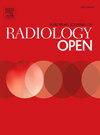深度学习在非增强胸部CT磨玻璃结节三级分类中的应用:CNN架构的多中心对比研究
IF 2.9
Q3 RADIOLOGY, NUCLEAR MEDICINE & MEDICAL IMAGING
引用次数: 0
摘要
目的建立、验证并比较4种三维(3D)卷积神经网络(CNN)模型在非对比胸部计算机断层扫描(CT)上鉴别毛玻璃结节(ggn),并将其分类为腺瘤性增生(AAH)/原位腺癌(AIS)、微创腺癌(MIA)和浸润性腺癌(IA)。材料和方法本多中心研究回顾性纳入了2015年1月至2023年12月间4家医院4284例手术切除并病理证实的AAH/AIS、MIA或IA患者。将ggn随机划分为训练集(n = 3083,72 %)和验证集(n = 1277,28 %)。采用Res2Net 3D、DenseNet3D、ResNet50 3D、Vision Transformer 3D四个三维深度学习模型对GGN进行分割和三类分类。此外,通过结合临床和CT特征,开发了Res2Net 3D模型的不同版本:Res2Net 3D_w2(性别、年龄),Res2Net 3D_w6(添加病变大小、位置和吸烟史),Res2Net 3D_w10(性别、年龄、位置、CT衰减平均值、最大值和标准差、结节体积、体积比、左右肺体积比、全肺最大CT值)。通过准确性、召回率、精密度、f1评分和受试者工作特征曲线(AUC)下面积来评估模型的性能。结果res2net 3D的auc分别为0.91 (AAH/AIS)、0.88 (MIA)和0.92 (IA)。其f1得分分别为0.416、0.500和0.929。所有Res2Net变体的准确率都在0.83-0.84之间。结论Res2Net三维模型在非对比CT上能准确鉴别GGN亚型,对浸润性腺癌具有较高的鉴别价值。本文章由计算机程序翻译,如有差异,请以英文原文为准。
Deep learning for Three‐Class Classification of ground-glass nodules on non-enhanced chest CT: A multicenter comparative study of CNN architectures
Objective
To develop, validate, and compare four three-dimensional (3D) convolutional neural network (CNN) models for differentiating ground-glass nodules (GGNs) on non-contrast chest computed tomography (CT) scans, specifically classifying them as adenomatous hyperplasia (AAH)/adenocarcinoma in situ (AIS), minimally invasive adenocarcinoma (MIA), or invasive adenocarcinoma (IA).
Materials and methods
This multi-center study retrospectively enrolled 4284 consecutive patients with surgically resected and pathologically confirmed AAH/AIS, MIA, or IA from four hospitals between January 2015 and December 2023. GGNs were randomly partitioned into a training set (n = 3083, 72 %) and a validation set (n = 1277, 28 %). Four 3D deep learning models (Res2Net 3D, DenseNet3D, ResNet50 3D, Vision Transformer 3D) were implemented for GGN segmentation and three-class classification. Additionally, variants of the Res2Net 3D model were developed by incorporating clinical and CT features: Res2Net 3D_w2 (sex, age), Res2Net 3D_w6 (adding lesion size, location, and smoking history), and Res2Net 3D_w10 (sex, age, location, the mean, maximum, and standard deviation of CT attenuation, nodule volume, volume ratio, volume ratio within the left/right lung, and the maximum CT value of the entire lung). Model performance was evaluated using accuracy, recall, precision, F1-score, and area under the receiver operating characteristic curve (AUC).
Results
Res2Net 3D outperformed others, achieving AUCs of 0.91 (AAH/AIS), 0.88 (MIA), and 0.92 (IA). Its F1-scores were 0.416, 0.500, and 0.929, respectively. All Res2Net variants achieved accuracies between 0.83–0.84.
Conclusion
The Res2Net 3D model accurately differentiates GGN subtypes using non-contrast CT, showing high performance, especially for invasive adenocarcinoma.
求助全文
通过发布文献求助,成功后即可免费获取论文全文。
去求助
来源期刊

European Journal of Radiology Open
Medicine-Radiology, Nuclear Medicine and Imaging
CiteScore
4.10
自引率
5.00%
发文量
55
审稿时长
51 days
 求助内容:
求助内容: 应助结果提醒方式:
应助结果提醒方式:


